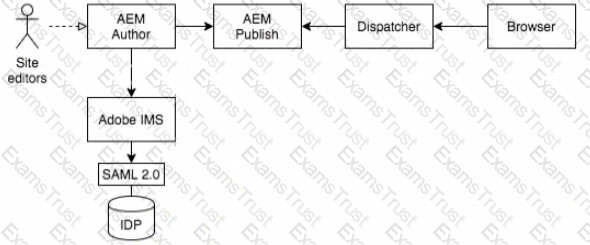Refer to the exhibit.

A customer has SSO on its AEM Author environment using Adobe IMS, which is integrated with the customer's IDP using SAML The customer plans to roll out a new secured website on AEM where SSO authentication is required for end users. The end user accounts are also managed in the customer's existing IDP.
How should the Architect set up the authentication for the website?
A new AEM Sites implementation includes a component that lists the 10 most recently published PDF documents in AEM Assets. The component works as expected during development and passes QA testing. The business starts to use it while entering content and uploading assets in preparation for go-live. A few days later, the component's PDF list is empty.
What is the most likely cause of the issue?
A customer is migrating from their On-Premises AEM 6.4 instances to AEM as a Cloud Service. Next to the required code refactoring, a content migration of approximately 100,000 pages needs to be performed. The customer wants the content freeze period to be limited so that editors can continue to do content actions as long as possible.
Which two recommendations should the Architect make for the migration of the content pages? (Choose two.)
A client is modernizing some of their AEM sites to go from static to editable templates so they can use the latest features around has the following parameters:
• The client currently has a dozen static templates that they want to move to editable templates.
• The existing pages use the parsys paragraph system for storing components.
• Each page based on one of the static templates has its own custom properties tab that is unique for that template type.
• The client wants template authors to be able to create the editable templates.
Which approach should an Architect use to meet these requirements?
A client is using AEM and wants to make sure they are managing their configurations correctly. Refer to the following requirements:
The client has multiple brands that they will be hosting on a single AEM implementation
The client wants to reuse as much between brands as possible
Each brand needs to be able to override the default values for items like contact us information
The client plans to support multiple languages in multiple regions for each brand
Each brand/language/region combination will have its own set of content approvers used as part of a custom workflow
Which approach should an Architect recommend to manage the client's configurations for AEM?
A client recently purchased the Smart Content Service and is considering using the Enhanced Smart Tagging feature. As part of the process, the client recently created a new tagging taxonomy that has not been applied to any assets yet. An Architect needs to demonstrate the feature on a subset of the client's assets before using on all assets.
How should the Architect proceed?
During the implementation of a public-facing website based on AEM as a Cloud Service, the customer raises an additional requirement to have a commenting functionality for end users implemented on the pages.
What should the Architect do to make the design a future proof solution?